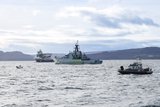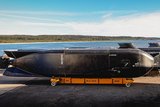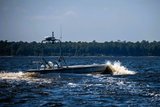Russia launches final Project 636.3 submarine for Pacific fleet
The Yakutsk was launched in St Petersburg in October 2024. (Photo: Admiralty Shipyards)
Russia has launched its sixth – and presumed final – Project 636.3 submarine in its Pacific fleet, the Yakutsk, in St Petersburg.
The submarine will largely be sent to work in the Russian Federation’s sphere of operations in the Far East.
The submarine was taken from the Admiralty Shipyards production hall in St Petersburg to the dock and submerged to gain buoyancy on 11 October 2024. While it still has to undergo factory trials and was described as “90% ready” by the company in October, Admiralty predicted the vessel would be at sea by the end of the year.
Related Articles
Russian Navy to receive trio of new submarines
The six submarines of Project 636.3 were designed as a modern variant of the Project 877 Paltus vessels, and are currently the most numerous among Russia’s conventionally-powered submarines due to a range of defects in the Project 677 Lada design, which led the Russian Navy to reject that vessel.
While the Pacific fleet’s Project 636.3 cohort will be complete with the launch to sea of the Yakutsk, submarines of its fundamental type, the Improved Kilo II in NATO reporting code, will continue to add to the Russian Navy’s arsenal. Plans are already well advanced for the keel-laying of the Petrozavodsk, which will likely report to the Baltic fleet, and three additional submarines destined for the Northern fleet.
Admiralty Shipyards is a longstanding supplier of submarines for the various Russian fleets. It has been solely responsible for the building of all the Project 636.3 vessels for the Pacific fleet since 2016, and previously built the first six such submarines for the Black Sea fleet between 2010 and 2016.
Related Programmes in Defence Insight
Improved Kilo/Varshavyanka Class (Project 636.3) 6-12
Improved Kilo/Varshavyanka Class (Project 636.3) 13
Related Equipment in Defence Insight
More from Naval Warfare
-
![Canadian Coast Guard’s OOSV delivery is “major milestone” in fleet modernisation]()
Canadian Coast Guard’s OOSV delivery is “major milestone” in fleet modernisation
The Polar Class 6 platform is the largest CCG science-dedicated vessel and will operate on the country’s east coast.
-
![How the Anduril-HHI autonomous ship plan fits in with the US Navy’s MASC programme]()
How the Anduril-HHI autonomous ship plan fits in with the US Navy’s MASC programme
The new modular vessel is expected to be developed for both commercial and defence use, with a heavy focus on production speed and mission flexibility.
-
![Indo Pacific 2025: Autonomous systems reigned but can the Australian Defence Force afford it?]()
Indo Pacific 2025: Autonomous systems reigned but can the Australian Defence Force afford it?
Multiple autonomous systems and technologies were on display at this year’s Indo Pacific, but questions remain over how the Australian Department of Defence will balance the books.
-
![US Navy starts acquisition process for uncrewed maritime systems for support missions]()
US Navy starts acquisition process for uncrewed maritime systems for support missions
The USN is interested in uncrewed capabilities that can carry out explosive ordnance disposal, mine countermeasures, force protection, ISR and anti-submarine missions.






















